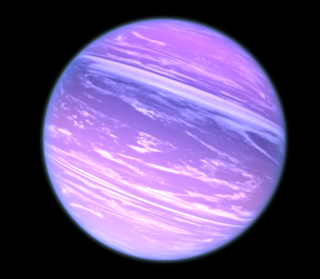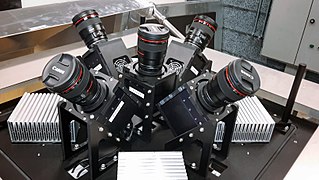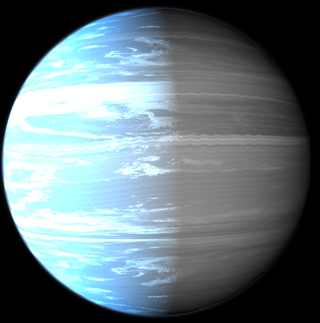Related Research Articles

Hot Jupiters are a class of gas giant exoplanets that are inferred to be physically similar to Jupiter but that have very short orbital periods. The close proximity to their stars and high surface-atmosphere temperatures resulted in their informal name "hot Jupiters".

WASP-19b, formally named Banksia, is an exoplanet, notable for possessing one of the shortest orbital periods of any known planetary body: 0.7888399 days or approximately 18.932 hours. It has a mass close to that of Jupiter, but by comparison has a much larger radius ; making it nearly the size of a low-mass star. It orbits the star WASP-19 in the Vela constellation. At the time of discovery it was the shortest period hot Jupiter discovered as planets with shorter orbital periods had a rocky, or metallic composition.
WASP-33b is an extrasolar planet orbiting the star HD 15082. It was the first planet discovered to orbit a Delta Scuti variable star. With a semimajor axis of 0.026 AU and a mass likely greater than Jupiter's, it belongs to the hot Jupiter class of planets.

WASP-43b, formally named Astrolábos, is a transiting planet in orbit around the young, active, and low-mass star WASP-43 in the constellation Sextans. The planet is a hot Jupiter with a mass twice that of Jupiter, but with a roughly equal radius. WASP-43b was flagged as a candidate by the SuperWASP program, before they conducted follow-ups using instruments at La Silla Observatory in Chile, which confirmed its existence and provided orbital and physical characteristics. The planet's discovery was published on April 14, 2011.

KELT-2Ab is an extrasolar planet that orbits the star KELT-2A approximately 440 light-years away in the constellation of Auriga. It was discovered by the KELT-North survey via the transit method, so both its mass and radius are known quite precisely. As of its discovery KELT-2Ab is the fifth-brightest transiting Hot Jupiter known that has a well constrained mass. This makes the KELT-2A system a promising target for future space- and ground-based follow-up observations to learn about the planet's atmosphere.

GJ 3470 b is an exoplanet orbiting the star GJ 3470, located in the constellation Cancer. With a mass of just under 14 Earth-masses and a radius approximately 4.3 times that of Earth's, it is likely something akin to Neptune despite the initially strong belief that the planet was not covered in clouds like the gas giants in the Solar System.
KELT-11b is an exoplanet orbiting around the yellow subgiant star KELT-11 about 320 light-years away from Earth. It is an inflated planet, one of the "puffiest planets" known, as a result of its close orbiting distance with its parent star. It has a radius 1.37 times that of Jupiter, but only 19% of its mass. It was discovered in 2016.

KELT-9b is an exoplanet. More specifically, an ultra-hot Jupiter that orbits the late B-type/early A-type star KELT-9, located about 670 light-years from Earth. Detected using the Kilodegree Extremely Little Telescope, the discovery of KELT-9b was announced in 2016. As of October 2022, it is the hottest known exoplanet.

WASP-121b, formally named Tylos, is an exoplanet orbiting the star WASP-121. WASP-121b is the first exoplanet found to contain water in an extrasolar planetary stratosphere. WASP-121b is in the constellation Puppis, and is about 858 light-years from Earth.

MASCARA is an exoplanet experiment by Leiden University. It has two stations, one in each hemisphere, each of which use cameras to make short exposure photographs of most of the visible sky to observe stars to a magnitude of 8.4. The Northern Hemisphere station at Roque de los Muchachos Observatory, La Palma, started observations in February 2015. The Southern Hemisphere station at La Silla Observatory, Chile, saw first light in July 2017.
KELT-21b is an extrasolar planet discovered in 2017. It is a hot Jupiter with radius of about 1.586 MJ.

WASP-76b is an exoplanet classified as a Hot Jupiter. It is located in the constellation Pisces and orbits its host star, WASP-76, at a distance of approximately 0.033 astronomical units (AU). The orbital period of WASP-76b is approximately 1.8 days. Its mass is about 0.92 times that of Jupiter. The discovery of WASP-76b took place on October 21, 2013, and it is currently the only known planet in the WASP-76 system as of 2022. The equilibrium temperature of WASP-76b is estimated to be around 2,190 K, However, the measured daytime temperature is even hotter, reaching approximately 2,500 ± 200 K.
HAT-P-18 is a K-type main-sequence star about 530 light-years away. The star is very old and has a concentration of heavy elements similar to solar abundance. A survey in 2015 detected very strong starspot activity on HAT-P-18.
BD-07 436, also known as WASP-77 since 2012, is a binary star system about 344 light-years away. The star's components appears to have a different age, with the secondary older than 9 billion years, while the primary's age is 5 billion years. The BD-07 436 system's concentration of heavy elements is similar to the Sun. Its stars display moderate chromospheric activity, including x-ray flares.
WASP-52 is a K-type main-sequence star about 570 light-years away. It is older than the Sun at 10.7+1.9
−4.5 billion years, but it has a similar fraction of heavy elements. The star has prominent starspot activity, with 3% to 14% of the stellar surface covered by areas 575±150 K cooler than the rest of the photosphere.
KELT-1 is a F-type main-sequence star. Its surface temperature is 6518±50 K. It is similar to the Sun in its concentration of heavy elements, with a metallicity Fe/H index of 0.008±0.073, but is much younger at an age of 1.75±0.25 billion years. The star is rotating very rapidly.
HAT-P-41 is a binary star system. Its primary is a F-type main-sequence star. Its surface temperature is 6390±100 K. compared to the Sun, HAT-P-41 is enriched in heavy elements, with a metallicity Fe/H index of 0.21±0.10, but is much younger at an age of 2.2±0.4 billion years.
WASP-80 is a K-type main-sequence star about 162 light-years away. The star's age is much younger than the Sun's at 1.352±0.222 billion years. WASP-80 is similar to the Sun in concentration of heavy elements, although this measurement is highly uncertain.

KELT-6b is an exoplanet orbiting the F-type subgiant KELT-6 approximately 791 light years away in the northern constellation Coma Berenices. It was discovered in 2013 using the transit method, and was announced in 2014.
References
- ↑ Fu, Guangwei; Sing, David K.; Lothringer, Joshua D.; Deming, Drake; Ih, Jegug; Kempton, Eliza M. -R.; Malik, Matej; Komacek, Thaddeus D.; Mansfield, Megan; Bean, Jacob L. (2022), "Strong H2O and CO Emission Features in the Spectrum of KELT-20b Driven by Stellar UV Irradiation", The Astrophysical Journal Letters, 925: L3, arXiv: 2201.02261 , doi: 10.3847/2041-8213/ac4968
- ↑ Kasper, David; Bean, Jacob L.; Line, Michael R.; Seifahrt, Andreas; Brady, Madison T.; Lothringer, Joshua; Pino, Lorenzo; Fu, Guangwei; Pelletier, Stefan; Stürmer, Julian; Benneke, Björn; Brogi, Matteo; Désert, Jean-Michel (2023), "Unifying High- and Low-resolution Observations to Constrain the Dayside Atmosphere of KELT-20b/MASCARA-2b", The Astronomical Journal, 165: 7, arXiv: 2208.04759 , doi: 10.3847/1538-3881/ac9f40
- ↑ Yan, F.; Reiners, A.; Pallé, E.; Shulyak, D.; Stangret, M.; Molaverdikhani, K.; Nortmann, L.; Mollière, P.; Henning, Th.; Casasayas-Barris, N.; Cont, D.; Chen, G.; Czesla, S.; Sánchez-López, A.; López-Puertas, M.; Ribas, I.; Quirrenbach, A.; Caballero, J. A.; Amado, P. J.; Galadí-Enríquez, D.; Khalafinejad, S.; Lara, L. M.; Montes, D.; Morello, G.; Nagel, E.; Sedaghati, E.; Zapatero Osorio, M. R.; Zechmeister, M. (2022), "Detection of iron emission lines and a temperature inversion on the dayside of the ultra-hot Jupiter KELT-20b", Astronomy & Astrophysics, 659: A7, arXiv: 2201.08759 , doi:10.1051/0004-6361/202142395, S2CID 246210387